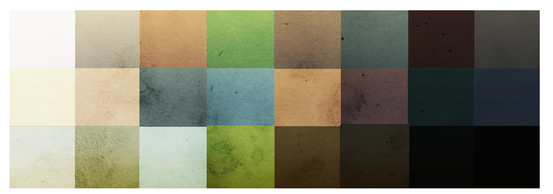Coloration
Common esk come in neutral or earth tones
Shades of gray and brown are common for esk. Bright colors must be desaturated in order to be used and soft greens and blues are also permissible as long as they are not fully saturated. Most esk have a pale face and tail with legs that are darker than most of the body, but lighter colored legs and darker tails are not uncommon. Dark faces, however, are an uncommon trait. A common esk's face must be lighter or similar in lightness to the majority of the body or area surrounding the face.
Shades of gray and brown are common for esk. Bright colors must be desaturated in order to be used and soft greens and blues are also permissible as long as they are not fully saturated. Most esk have a pale face and tail with legs that are darker than most of the body, but lighter colored legs and darker tails are not uncommon. Dark faces, however, are an uncommon trait. A common esk's face must be lighter or similar in lightness to the majority of the body or area surrounding the face.
Markings
Common esk have mostly soft markings that blend with each other that are usually soft and simple gradients but some hard edges are permissible. Markings with hard edges can be considered common as long as the colors are not in high contrast to each other. Legs can have a hard edge where they meet the body. Areas that have similar colors next to each other can have hard edges given that they do not have bold contrast against each other. Any color changes below the elbow should be a soft gradient, hard-edged socks are uncommon. Highly contrasting or bold markings with hard edges are uncommon, particularly very light markings with hard edges against very dark markings. Only rare esk can be solid colored.
The section on uncommon and rare traits goes into greater detail on common vs uncommon/rare markings.
Common esk have mostly soft markings that blend with each other that are usually soft and simple gradients but some hard edges are permissible. Markings with hard edges can be considered common as long as the colors are not in high contrast to each other. Legs can have a hard edge where they meet the body. Areas that have similar colors next to each other can have hard edges given that they do not have bold contrast against each other. Any color changes below the elbow should be a soft gradient, hard-edged socks are uncommon. Highly contrasting or bold markings with hard edges are uncommon, particularly very light markings with hard edges against very dark markings. Only rare esk can be solid colored.
The section on uncommon and rare traits goes into greater detail on common vs uncommon/rare markings.
Restricted traits
You can read about the restricted uncommon and rare traits elsewhere in this guide. These traits must be earned in the game by collecting points. Some basic colors and markings that must be unlocked include bright saturated colors, spots and stripes, symbols or patterns, high-contrast markings, dark faces, contrasting tail tips, solid coloration, albino or piebald, bright or glowing eyes, glowing markings, rainbow markings, and iridescence.
You can read about the restricted uncommon and rare traits elsewhere in this guide. These traits must be earned in the game by collecting points. Some basic colors and markings that must be unlocked include bright saturated colors, spots and stripes, symbols or patterns, high-contrast markings, dark faces, contrasting tail tips, solid coloration, albino or piebald, bright or glowing eyes, glowing markings, rainbow markings, and iridescence.



